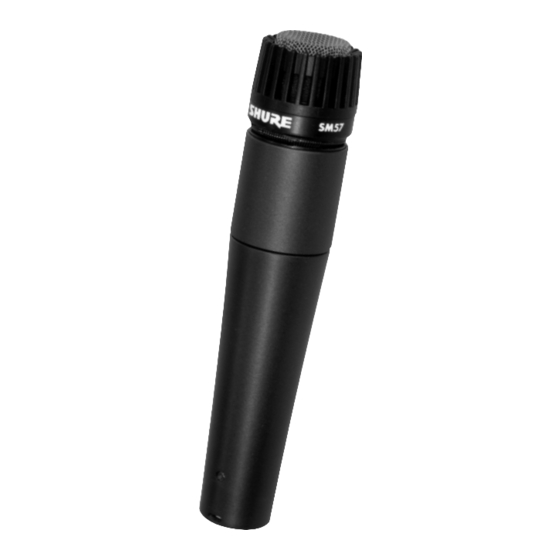Advertisement
Quick Links
MODEL SM57
UNIDIRECTIONAL DYNAMIC MICROPHONE
The Shure SM57 unidirectional dynamic microphone is excep-
tional for musical instrument pickup or for vocals. With its bright,
clean sound and carefully contoured presence rise, the SM57 is
ideal for live sound reinforcement and recording. It has an ex-
tremely effective cardioid pickup pattern which isolates the main
sound source while minimizing background noise. In the studio,
it is excellent for recording drums, guitar, and woodwinds. For
musical instruments or vocals, the SM57 is a consistent choice
of professional performers.
Features
Frequency response tailored for drums, guitars, and vocals
Uniform cardioid pickup pattern isolates the main sound
source while reducing background noise
Pneumatic shock-mount system cuts down handling noise
Extremely durable under the heaviest use
Supplied break-resistant swivel adapter that rotates 180
Legendary Shure quality, ruggedness, and reliability
STAGE MONITOR & P.A. LOUDSPEAKER PLACEMENT
Place the stage monitor directly behind the microphone
(see Figure 1). Locate the P.A. loudspeakers so that they
point away from the rear of the microphone. With the speak-
ers located in these positions, the possibility of feedback is
greatly reduced. Always check the stage setup before a per-
formance to ensure optimum placement.
STAGE
MONITOR
P.A.
LOUDSPEAKERS
RECOMMENDED LOUDSPEAKER PLACEMENT
FIGURE 1
1998, Shure Brothers Incorporated
27A2903 (RA)
90
0
180
MICROPHONE
90
SOURCE
Shure Brothers Incorporated
222 Hartrey Avenue
Evanston IL 60202-3696 U.S.A.
Model SM57 User Guide
APPLICATION AND PLACEMENT
Some of the most common applications and placement tech-
niques for the SM57 are listed in the following table. Remember
that microphone technique is largely a matter of personal
taste—there is no single "correct" microphone position.
APPLICA-
TION
Tom–Toms
Snare Drum
Guitar &
Bass
Amplifiers
Brass &
Woodwinds
Vocals &
Speech
PROXIMITY EFFECT
When the sound source is less than 6 mm (
microphone, the microphone boosts bass frequencies (by 6 to
10 dB at 100 Hz), creating a warmer and richer bass sound
than when farther away. This effect, known as proximity effect,
happens in unidirectional microphones like the SM57. The
SM57 low-frequency roll-off provides greater control, allowing
the user to take full advantage of proximity effect.
SOUND
SUGGESTED MICROPHONE
PLACEMENT
One SM57 on each tom, or
between each pair of toms, 25
mm (1 in.) to 75 mm (3 in.)
above the heads. Aim each
mic at the top heads.
On double head toms, remove
the bottom head and place a
mic inside aimed at the head.
25 mm (1 in.) to 75 mm (3 in.)
above the rim of the top head
of the drum. Aim the mic at
the head.
If desired, place a second mic
just below the rim of the bot-
tom head.
25 mm (1 in.) from the speak-
er, on-axis with the speaker
cone.
150 mm (6 in.) to 300 mm (12
in.) away from speaker and
on-axis with speaker cone.
.5 m (18 in.) to 1 m (3 ft) back
from the speaker, on-axis with
the speaker cone.
On-axis with the edge of the
speaker cone.
Brass: .3 m (1 ft) to 1 m (3 ft)
away, on-axis with bell of in-
strument.
Woodwinds: 25 mm (1 in.) to
150 mm (6 in.) away, on-axis
with bell of instrument.
Bell of the instrument 90 off-
axis from the front of the mic.
25 mm (1 in.) to 150 mm (6
in.) from the vocalist's mouth.
TONE QUALITY
Medium attack,
balanced sound.
Medium attack,
balanced sound.
Most "snap"
from drumstick
impact
More "snare"
sound.
Most attack,
emphasized
bass
Medium attack,
full, balanced
sound
Softer attack,
thin, reduced
bass sound.
Thinner, re-
duced bass
sound.
Bright, clear
sound.
Bright, clear
sound.
Softer, mellow
sound.
Rich, warm
sound.
1
/
in.) from the
4
Printed in U.S.A.
Advertisement

Summary of Contents for Shure SM57
- Page 1 Model SM57 User Guide APPLICATION AND PLACEMENT Some of the most common applications and placement tech- niques for the SM57 are listed in the following table. Remember that microphone technique is largely a matter of personal taste—there is no single “correct” microphone position.
- Page 2 For additional service or parts information, please contact Open Circuit Voltage: –74.5 dB* (0.19 mV) Shure’s Service department at 1-800-516-2525. Outside the Power Level: –56.0 dB** United States, please contact your authorized Shure Service *0 dB = 1 V/mbar **0 dB = 1 mW/10 mbar Center.

















Need help?
Do you have a question about the SM57 and is the answer not in the manual?
Questions and answers